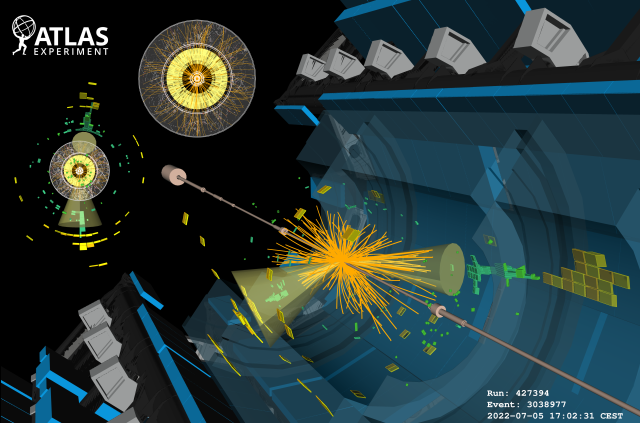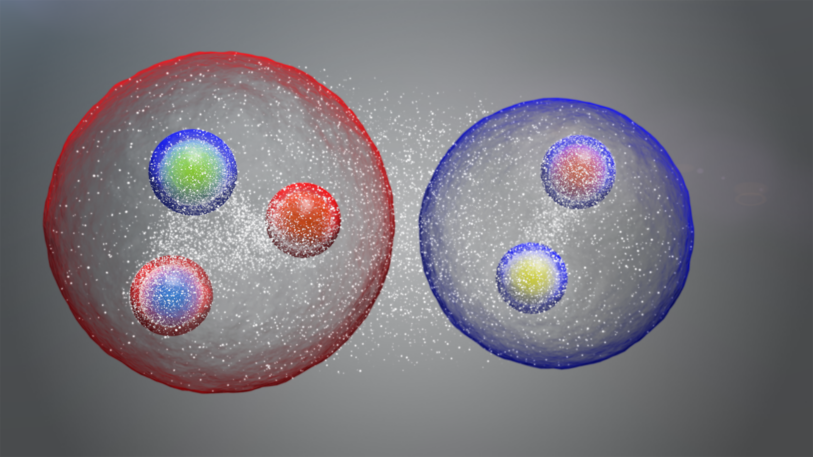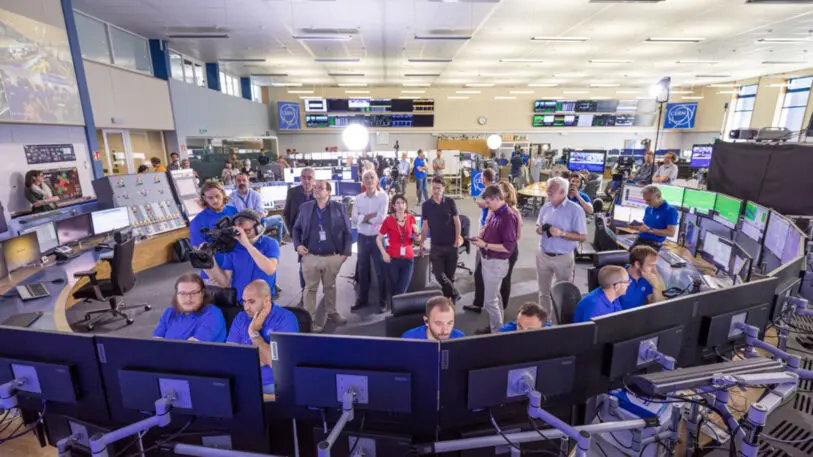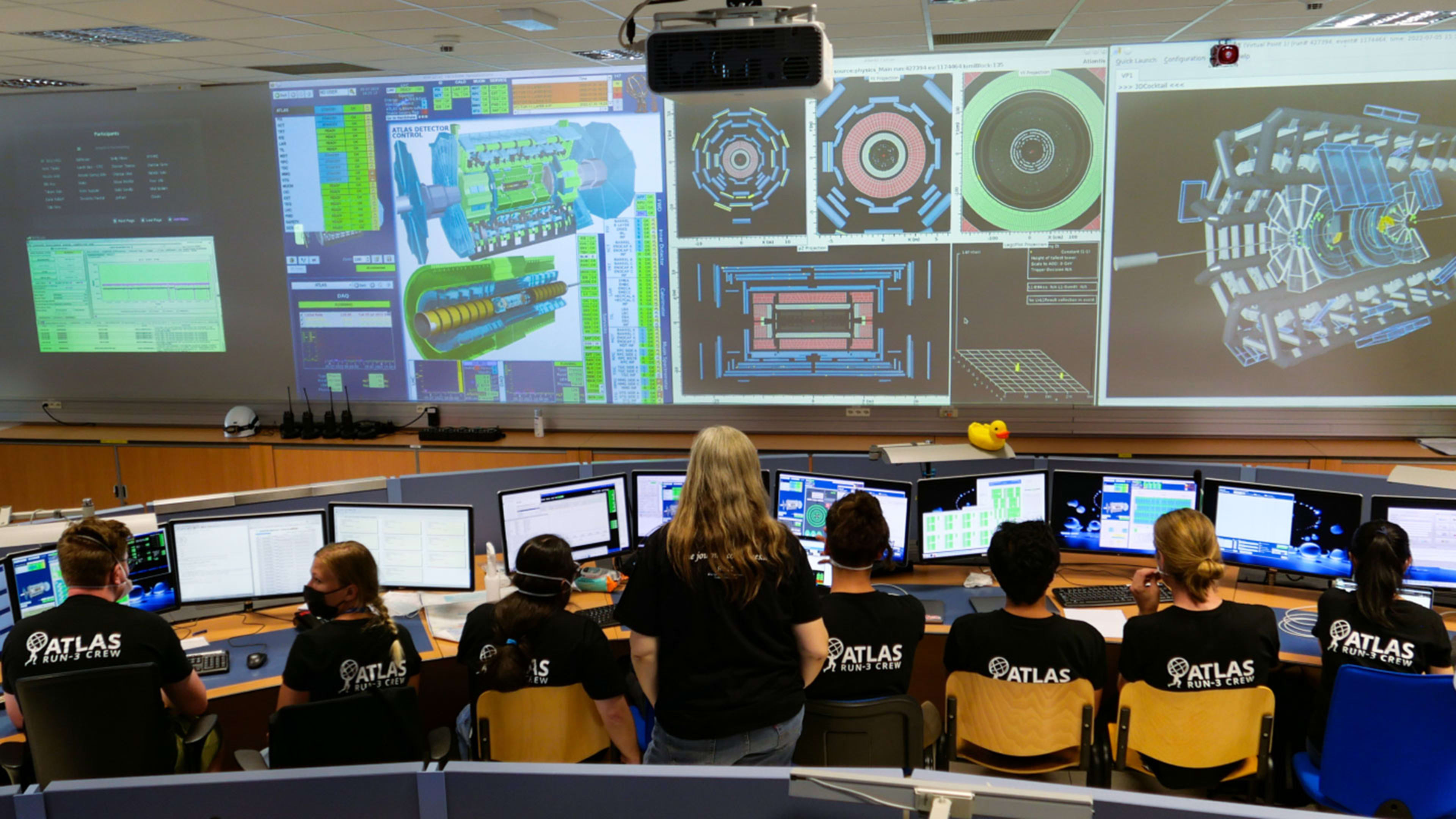Physicists at the world’s largest atom collider have observed three new exotic particles as they continue to search for clues about the mysterious forces that bind subatomic particles together, they said on Tuesday.
The observation of the particles—a new type of pentaquark and the first duo of tetraquarks—came on a momentous day at CERN, the Geneva lab, which on Tuesday also fired up its Large Hadron Collider again, after a three-year hiatus, with the machine’s most powerful beam of energy yet.
Maintenance on the ATLAS Experiment. [Image: CERN]The restart, following painstaking maintenance and repairs, offers another chance for a global network of scientists to look for the “strong force” that holds together the nuclei of atoms. The strong force is one of four forces that govern the decay of particles, including the electromagnetic force, gravity, and the “weak force.”
This week also marks the the 10th anniversary of the confirmation of the Higgs boson, a milestone at CERN that helped to solidify the so-called Standard Model, which accounts for the basics of particle physics. The Higgs, named for the Nobel Prize-winning physicist who theorized it, helps give all matter its mass, and is thought to have been present at the creation of the universe, moments after the Big Bang 13.7 billion years ago.
But physicists still have questions about the Higgs, and they’re looking beyond the Standard Model. It’s the most comprehensive one we have, but it doesn’t explain where gravity comes from, what dark matter is, or why there is so much more matter than antimatter in the universe.
Enter the LHC. Around its giant underground ring, stretching beneath 27-kilometers of countryside across the Swiss-French border, a series of superconducting magnets help propel subatomic particles to near light speed in order to smash them together as powerfully as possible.
Explosive collisions, powerful results
In particle accelerators like this, slamming protons together at high energy can produce tiny fragments of the universe not normally seen. As in a car crash, where more explosive collisions result in smaller fragments, the higher the energy, the higher chance that the LHC’s detectors will be able to help researchers pick up traces of the tiniest, most exotic particles.

The particle beams wlll be denser too, further increasing the probability of a collision, and the chance of producing Higgs bosons, finding new particles, and perhaps new physics. Among the highly sought-after prizes is the axion, a particle thought to not emit, absorb, or reflect light. It’s one leading contender for the make-up of dark matter, the mysterious stuff that physicists think accounts for 85% of the matter in the universe.
https://www.youtube.com/watch?v=9MPNVPlfQxk
The new particles
The first-ever pair of tetraquarks and the new pentaquark, discovered in torrents of data gathered during previous research at the LHC, will help explain how subatomic particles form. The particles that make up the mass of most ordinary matter, like the protons and neutrons that make up the nuclei of atoms, are known as hadrons, and the more exotic hadrons are made up of two or three elemental particles called quarks.
But six decades ago, physicists began theorizing that, in rare cases, these combos can form four-quark and five-quark particles. Only in the past decade have these so-called tetraquarks and pentaquarks actually been observed by the LHC and other experiments. The new pentaquark is the first found to contain a strange quark.

“We’re witnessing a period of discovery similar to the 1950s, when a ‘particle zoo’ of hadrons started being discovered and ultimately led to the quark model of conventional hadrons in the 1960s,” physicist Niels Tuning said in a statement. “We’re creating ‘particle zoo 2.0.'”
Specifically, the new findings will help theorists develop a unified model of exotic hadrons, and better understand conventional hadrons. While some theories describe exotic hadrons as “balls” of tightly bound quarks, other theoretical models imagine them as pairs of standard hadrons that are loosely bound in a molecule-like structure. More research is required to know if either or both theories are true.
Researchers at CERN said the pentaquark finding has a whopping statistical significance of 15 standard deviations, way beyond the 5 standard deviations that are required by the physics community to claim the observation of a particle. The new tetraquarks, observed with a statistical significance of 6.5 and 8 standard deviations respectively, are the first time a pair of tetraquarks has been observed.
An international effort
There is no larger particle physics lab. More than 5,500 scientists from 245 institutes in over 40 countries work on the LHC’s largest experiment, ATLAS. Other new experiments at CERN probing the nature of the universe will focus on collisions of high-energy ions, to better understand the plasma that was present only in the first microsecond after the Big Bang; probe the insides of protons; study cosmic rays; and search for the still-hypothetical magnetic monopole, an isolated magnet with only one magnetic pole. Other detectors will help researchers study extremely light and weakly interacting particles, like neutrinos and dark matter.

The multibillion-euro project is funded by contributions from each participant country. For fiscal year 2022, the Biden administration initially allocated only $40 million for future upgrades at the LHC, well below the about $90 million needed. The Department of Energy subsequently diverted an additional $25 million from various other physics projects, including a set of upgrades at Fermilab, and the Biden administration is now requesting $85 million, the American Institute of Physics reported.
During this run, the researchers behind LHC’s two main experiments will collide bunches of around 100 billion protons at a rate of 40 million collisions per second, each one producing around 60 smashes, each of which will generate hundreds of particles.
“The more analyses we perform, the more kinds of exotic hadrons we find,” Tuning said.
• Video: An inside look at the Large Hadron Collider: part 1 and part 2
• CERN designers are celebrating the web’s 30th birthday by rebuilding it
• What is a muon? Meet the subatomic particle that might be breaking the rules of physics
Recognize your brand’s excellence by applying to this year’s Brands That Matter Awards before the early-rate deadline, May 3.
